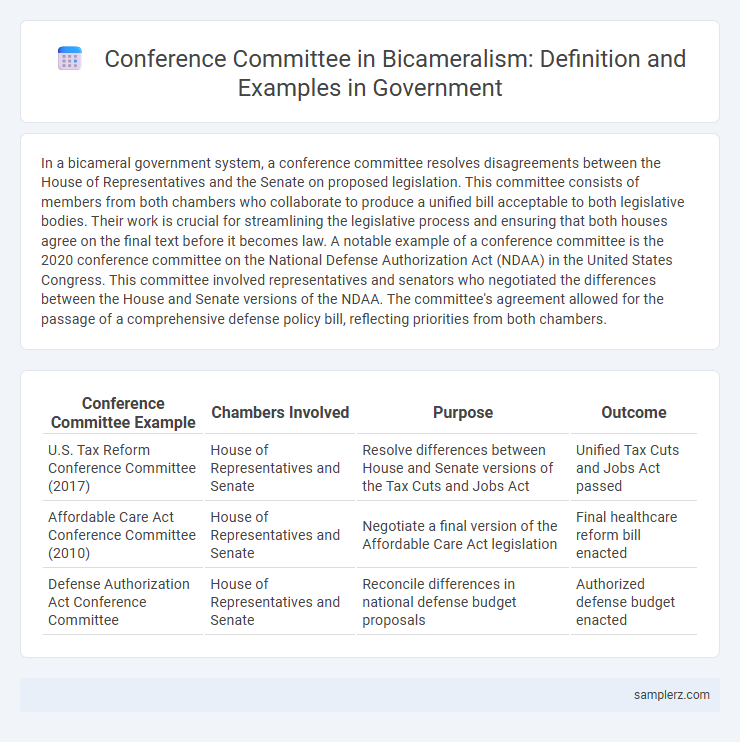In a bicameral government system, a conference committee resolves disagreements between the House of Representatives and the Senate on proposed legislation. This committee consists of members from both chambers who collaborate to produce a unified bill acceptable to both legislative bodies. Their work is crucial for streamlining the legislative process and ensuring that both houses agree on the final text before it becomes law. A notable example of a conference committee is the 2020 conference committee on the National Defense Authorization Act (NDAA) in the United States Congress. This committee involved representatives and senators who negotiated the differences between the House and Senate versions of the NDAA. The committee's agreement allowed for the passage of a comprehensive defense policy bill, reflecting priorities from both chambers.
Table of Comparison
| Conference Committee Example | Chambers Involved | Purpose | Outcome |
|---|---|---|---|
| U.S. Tax Reform Conference Committee (2017) | House of Representatives and Senate | Resolve differences between House and Senate versions of the Tax Cuts and Jobs Act | Unified Tax Cuts and Jobs Act passed |
| Affordable Care Act Conference Committee (2010) | House of Representatives and Senate | Negotiate a final version of the Affordable Care Act legislation | Final healthcare reform bill enacted |
| Defense Authorization Act Conference Committee | House of Representatives and Senate | Reconcile differences in national defense budget proposals | Authorized defense budget enacted |
Defining Bicameralism and Conference Committees
Bicameralism is a legislative system consisting of two separate chambers or houses, typically the Senate and the House of Representatives, each with distinct roles in the lawmaking process. Conference committees are specialized bicameral committees formed to reconcile differences between the House and Senate versions of a bill, ensuring legislative consistency. These committees play a critical role in achieving compromise and finalizing legislation before it is sent to the executive for approval.
Historical Origins of Conference Committees
The historical origins of conference committees trace back to the early U.S. Congress in the late 18th century, where these committees were established to resolve differences between House and Senate versions of legislation. Early examples include the 1789 conference committee formed to reconcile variations in the First Judiciary Act. Such committees became integral to the bicameral legislative process, ensuring coherence and compromise between the two chambers.
Structure of Conference Committees in Bicameral Legislatures
Conference committees in bicameral legislatures consist of a balanced group of members drawn from both the House of Representatives and the Senate, typically including experienced legislators familiar with the bill's content. These committees are structured to reconcile differences between the two chambers' versions of a bill by negotiating and producing a compromise report for final approval. The committee's composition often reflects proportional representation based on party strength to ensure equitable participation and influence from each chamber.
Roles and Responsibilities of Conference Committees
Conference committees in bicameral legislatures resolve differences between House and Senate versions of a bill, ensuring both chambers agree on a unified text. These committees review, negotiate, and amend legislative proposals to harmonize divergent provisions, preventing legislative deadlock. Their role is crucial in streamlining the legislative process and enabling the passage of coherent, effective laws.
Notable Examples of Conference Committees in Parliamentary Systems
The UK Parliament's conference committee plays a crucial role in resolving legislative differences between the House of Commons and the House of Lords, exemplifying effective bicameral negotiation. In Canada, the Conference Committee on Bill C-76 demonstrated the committee's function in harmonizing perspectives between the House of Commons and the Senate to finalize electoral reform legislation. Australia's bicameral system utilizes conference committees to reconcile amendments between the House of Representatives and the Senate, ensuring coherent lawmaking especially on budgetary and policy matters.
Case Study: Conference Committees in the U.S. Congress
Conference committees in the U.S. Congress serve as essential mechanisms for resolving differences between the House of Representatives and the Senate on proposed legislation. This bicameral process enables members from both chambers to negotiate and reconcile distinct bill versions, ensuring a unified final text before enactment. The role of these committees exemplifies effective inter-chamber collaboration within the federal legislative framework.
Example: Conference Committees in the UK Parliament
Conference committees in the UK Parliament serve as a vital mechanism in bicameralism, resolving differences between the House of Commons and the House of Lords on legislation. These joint committees, composed of members from both houses, negotiate amendments to create a mutually acceptable version of a bill. This process ensures parliamentary consensus and maintains legislative efficiency within the UK's bicameral system.
International Comparisons: Bicameral Conference Committees
Bicameral conference committees serve as essential mechanisms to reconcile differing legislative versions between two chambers, ensuring coherent lawmaking processes in countries such as the United States, Canada, and Australia. The U.S. Congress frequently employs conference committees to resolve discrepancies between House and Senate bills, highlighting their critical role in passing federal legislation. In contrast, Canada's parliamentary system uses similar joint committees to harmonize provincial and federal interests, reflecting diverse bicameral approaches internationally.
Challenges Faced by Conference Committees
Conference committees in bicameral legislatures reconcile differing House and Senate bills but face significant challenges such as partisan deadlock, which impedes effective compromise. The complexity of aligning diverse policy priorities and procedural differences further complicates negotiations, often prolonging legislative processes. Limited transparency and public scrutiny can also reduce accountability, making consensus harder to achieve in critical government decisions.
Impact of Conference Committee Decisions on Legislation
Conference committees in bicameral legislatures significantly influence the final form of legislation by reconciling differences between House and Senate versions of bills. Their decisions can streamline legislative processes, reduce gridlock, and ensure that enacted laws incorporate compromises acceptable to both chambers. The committee's ability to merge diverse policy perspectives often determines the effectiveness and public acceptance of the resulting laws.

example of conference committee in bicameralism Infographic
 samplerz.com
samplerz.com